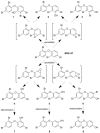Update of the risk assessment of polybrominated diphenyl ethers (PBDEs) in food
- PMID: 38269035
- PMCID: PMC10807361
- DOI: 10.2903/j.efsa.2024.8497
Update of the risk assessment of polybrominated diphenyl ethers (PBDEs) in food
Abstract
The European Commission asked EFSA to update its 2011 risk assessment on polybrominated diphenyl ethers (PBDEs) in food, focusing on 10 congeners: BDE-28, -47, -49, -99, -100, -138, -153, -154, -183 and ‑209. The CONTAM Panel concluded that the neurodevelopmental effects on behaviour and reproductive/developmental effects are the critical effects in rodent studies. For four congeners (BDE-47, -99, -153, -209) the Panel derived Reference Points, i.e. benchmark doses and corresponding lower 95% confidence limits (BMDLs), for endpoint-specific benchmark responses. Since repeated exposure to PBDEs results in accumulation of these chemicals in the body, the Panel estimated the body burden at the BMDL in rodents, and the chronic intake that would lead to the same body burden in humans. For the remaining six congeners no studies were available to identify Reference Points. The Panel concluded that there is scientific basis for inclusion of all 10 congeners in a common assessment group and performed a combined risk assessment. The Panel concluded that the combined margin of exposure (MOET) approach was the most appropriate risk metric and applied a tiered approach to the risk characterisation. Over 84,000 analytical results for the 10 congeners in food were used to estimate the exposure across dietary surveys and age groups of the European population. The most important contributors to the chronic dietary Lower Bound exposure to PBDEs were meat and meat products and fish and seafood. Taking into account the uncertainties affecting the assessment, the Panel concluded that it is likely that current dietary exposure to PBDEs in the European population raises a health concern.
Keywords: PBDEs; Polybrominated diphenyl ethers; food; human exposure; occurrence; risk assessment; toxicology.
© 2024 European Food Safety Authority. EFSA Journal published by Wiley‐VCH GmbH on behalf of European Food Safety Authority.
Conflict of interest statement
If you wish to access the declaration of interests of any expert contributing to an EFSA scientific assessment, please contact interestmanagement@efsa.europa.eu.
Figures












Similar articles
-
Probabilistic risk assessment of the exposure to polybrominated diphenyl ethers via fish and seafood consumption in the Region of Valencia (Spain).Chemosphere. 2014 Jun;104:7-14. doi: 10.1016/j.chemosphere.2013.12.084. Epub 2014 Feb 15. Chemosphere. 2014. PMID: 24534151 Review.
-
Dietary exposure of the Hong Kong adult population to polybrominated diphenyl ethers (PBDEs): results of the first Hong Kong Total Diet Study.Food Addit Contam Part A Chem Anal Control Expo Risk Assess. 2013;30(10):1780-7. doi: 10.1080/19440049.2013.820355. Epub 2013 Jul 26. Food Addit Contam Part A Chem Anal Control Expo Risk Assess. 2013. PMID: 23885643
-
A Human Mixture Risk Assessment for Neurodevelopmental Toxicity Associated with Polybrominated Diphenyl Ethers Used as Flame Retardants.Environ Health Perspect. 2017 Aug 23;125(8):087016. doi: 10.1289/EHP826. Environ Health Perspect. 2017. PMID: 28886598 Free PMC article.
-
Polybrominated diphenyl ethers in foods from the Region of Valencia: Dietary exposure and risk assessment.Chemosphere. 2020 Jul;250:126247. doi: 10.1016/j.chemosphere.2020.126247. Epub 2020 Feb 19. Chemosphere. 2020. PMID: 32109700
-
Polybrominated diphenyl ethers: human tissue levels and toxicology.Rev Environ Contam Toxicol. 2004;183:55-97. doi: 10.1007/978-1-4419-9100-3_3. Rev Environ Contam Toxicol. 2004. PMID: 15369322 Review.
Cited by
-
Guardians under Siege: Exploring Pollution's Effects on Human Immunity.Int J Mol Sci. 2024 Jul 16;25(14):7788. doi: 10.3390/ijms25147788. Int J Mol Sci. 2024. PMID: 39063030 Free PMC article. Review.
-
Scientific Committee guidance on appraising and integrating evidence from epidemiological studies for use in EFSA's scientific assessments.EFSA J. 2024 Jul 5;22(7):e8866. doi: 10.2903/j.efsa.2024.8866. eCollection 2024 Jul. EFSA J. 2024. PMID: 38974922 Free PMC article.
-
Endocrine disrupting potency of organic pollutant mixtures isolated from commercial fish oil evaluated in yeast-based bioassays.PLoS One. 2018 May 22;13(5):e0197907. doi: 10.1371/journal.pone.0197907. eCollection 2018. PLoS One. 2018. PMID: 29787602 Free PMC article.
-
Update of the risk assessment of brominated phenols and their derivatives in food.EFSA J. 2024 Oct 23;22(10):e9034. doi: 10.2903/j.efsa.2024.9034. eCollection 2024 Oct. EFSA J. 2024. PMID: 39444985 Free PMC article.
-
Constitutive androstane receptor, liver pathophysiology and chemical contaminants: current evidence and perspectives.Front Endocrinol (Lausanne). 2025 Apr 4;16:1472563. doi: 10.3389/fendo.2025.1472563. eCollection 2025. Front Endocrinol (Lausanne). 2025. PMID: 40255499 Free PMC article. Review.
References
-
- Abbasi, G. , Li, L. , & Breivik, K. (2019). Global historical stocks and emissions of PBDEs. Environmental Science and Technology, 53, 6330–6340. - PubMed
-
- Abdallah, M. A. , Pawar, G. , & Harrad, S. (2015). Effect of bromine substitution on human dermal absorption of Polybrominated diphenyl ethers. Environmental Science and Technology, 49, 10976–10983. - PubMed
-
- Abdallah, M. A. E. , & Harrad, S. (2014). Polybrominated diphenyl ethers in UK human milk: Implications for infant exposure and relationship to external exposure. Environmental International, 63, 130–136. - PubMed
-
- Abdelouahab, N. , Ainmelk, Y. , & Takser, L. (2011). Polybrominated diphenyl ethers and sperm quality. Reproductive Toxicology, 31, 546–550. - PubMed
-
- Abdelouahab, N. , Langlois, M. F. , Lavoie, L. , Corbin, F. , Pasquier, J. C. , & Takser, L. (2013). Maternal and cord‐blood thyroid hormone levels and exposure to polybrominated diphenyl ethers and polychlorinated biphenyls during early pregnancy. American Journal of Epidemiology, 178, 701–713. - PubMed
LinkOut - more resources
Full Text Sources
